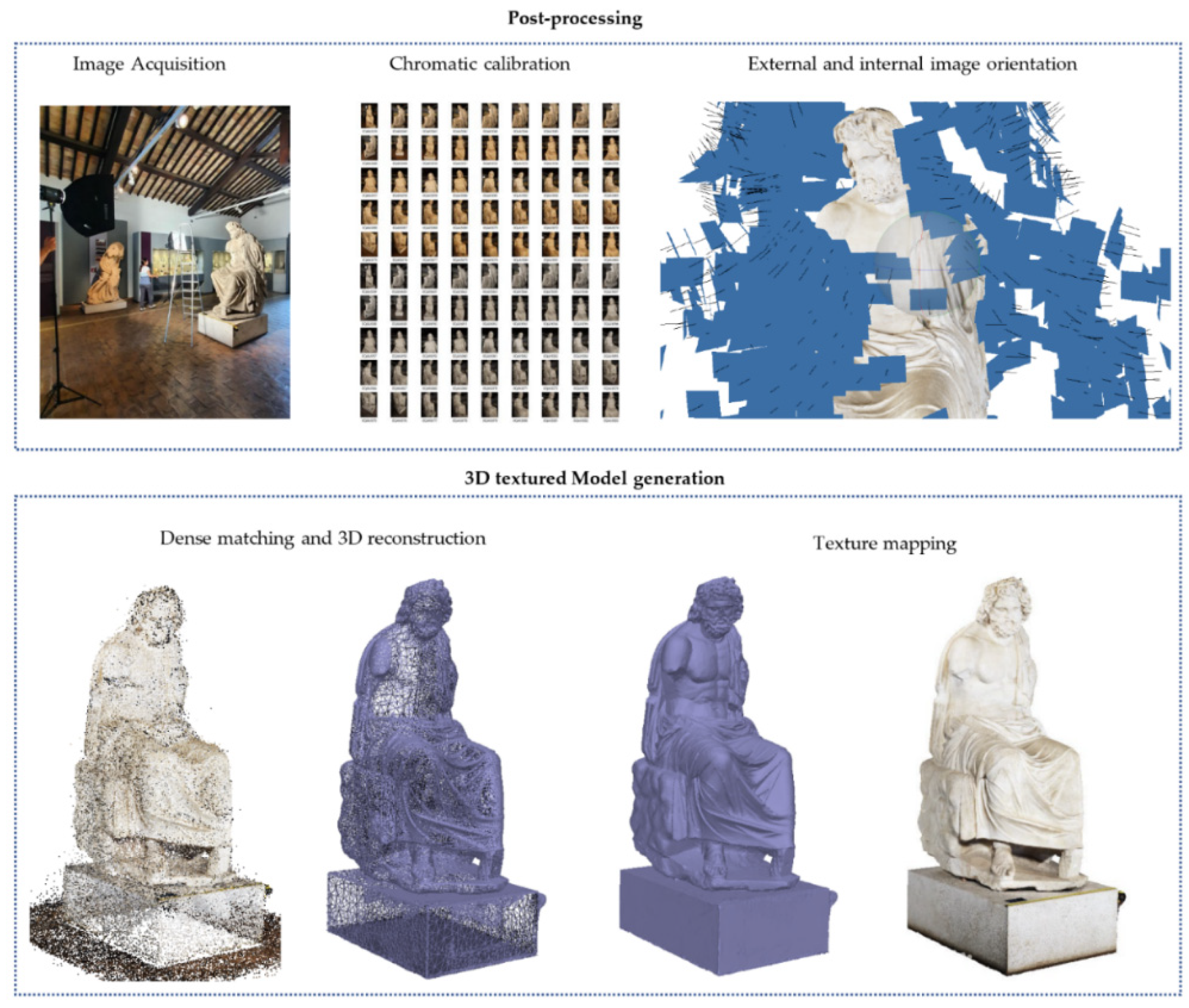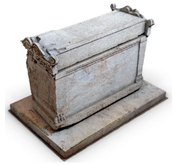1. Introduction
Italy is historically known for the presence of a pervasive cultural heritage, which corresponds to the vast and unique museum system. The pandemic has hit hard the cultural sector hard. The year 2020 meant the loss of 41.5 million visitors to the country’s museums, monuments, and archaeological sites. Regarding incomes, the regions that drive tourism have paid the price. Lazio lost 80.7% of visitors compared to 2019. Tuscany, where Florence stands out with the Uffizi, has over 75%. Campania is about 69%—from almost 55 million visitors in 2019 to just 13 million in 2020. It reverses a virtuous trend recorded since the 1990s, which has seen a notable increase in visitors and receipts. In 1996, the Ministry of Cultural Heritage recorded 25 million visitors and 52 million gross revenues. The 2020 data brings us back to numbers over 20 years ago [
1,
2] (
Figure 1).
An essential chapter of the investments envisaged by the National Recovery and Resilience Plan (NRR) [
4] concerns culture and Italian museums. The first one regards the 500 million euro investment between 2021 and 2026 concerning the digital strategy and platforms for cultural heritage. This intervention aims to digitise the heritage preserved in places of culture and create a national digital infrastructure to collect, integrate, and preserve digital resources, making them available for public use through dedicated platforms. For 300 million, a second intervention aims to remove the architectural and cognitive sense-perceptive barriers in various cultural institutions, such as museums, libraries, and archives. In addition, one crucial point is to increase access to cultural sites by people with disabilities. The third significant intervention is the 300 million investment to improve the energy efficiency of cultural facilities, including cinemas, theatres, and museums. One-third of the budget (100 million) is earmarked explicitly for State museums and cultural sites (for a total of 67 structures).
Accordingly, the dialogue between museums and public bodies has made it possible to increase visibility and attract attention, leading to a progressive expansion of the museum presence on the net [
5,
6], thanks to creating new internet sites and opening official profiles on the main social networks. In recent months, almost all museums have invested in digital communication to promote the museum itself and intercept an increasingly online audience where the boundary between real and digital has nearly vanished [
7,
8,
9].
On the other hand, digital technologies currently in use for the virtual representation of the built heritage can offer researchers and scholars a wide range of possibilities [
10]. Over the years, methodologies and operational practices have been developed in the architecture, restoration, and archaeology sectors based on the respective disciplines’ theoretical and methodological foundations. At the same time, on an international level, numerous research groups have set interesting, diversified approaches in terms of scientific and cultural backgrounds and operational practices [
11,
12,
13]. Thanks to the development of acquisition, analysis, and interactive digital representation methodologies and tools, it is possible to explain and convey the contents of museum collections through virtual and augmented reality (VR-AR) environments [
14].
In this context, it is helpful to understand which technologies can be used inside a museum and outside, trying to differentiate the level of interaction each technology offers [
15,
16]. Apps, totems, multimedia tables, multi-user touch tables, and video mapping are the primary tools for increasing knowledge within a multimedia path. However, they are considered low interaction and immersion. On the other hand, state-of-the-art tools based on VR-AR allow one to discover new levels of interactivity where virtual tourists can immerse themselves in ‘living’ environments and learn content, archive material, and storytelling. Different museums are working with these technologies to support and favour a moment characterised by significant social, economic, and cultural transformations in which technologies and digital have a considerable impact [
17,
18,
19,
20]. The virtual environments are designed for the museum to guarantee the best possible visiting experience, with captivating graphics and responsiveness to the institution’s visual identity. Furthermore, VR and AR contribute by offering new customer experiences, speeding up product development, and improving workplace safety [
21].
Representation, digital modelling, and the most advanced forms of immersive reality are added values for users to navigate and enjoy the work in its main features: spatiality, details, and entirety, as a sensitive and scientific experience. AR is considered an enhanced reality that enriches what we see through a mobile device such as a tablet or cell phone [
22,
23]. At the same time, VR is an interactive three-dimensional environment that replaces reality, allowing the user to navigate in the first or third person. Consequently, compared to AR, developing a VR environment requires much more effort in digital representation, modelling, development, and integration of VR devices [
24].
For those reasons, the research investigates the museum’s technological and digital transformation, supporting and promoting this flow of change through the development of VR-AR digital worlds and multimedia data able to integrate on-site museum reality, becoming the two sides of the same coin. It tries to leap a scale capable of generating further knowledge by exploiting interrelations in a systemic perspective and making heterogeneous contents such as VR-AR, 3D animation, videos, catalogues, 3D works, and descriptions available within information platforms able to interact with different types of users, from professionals to virtual tourists.
2. New Frontiers for Museums Communication through Virtual and Augmented Reality
Museums are facing challenges for new needs in contemporary societies of the twenty-first century. Waldfogel, studying the digital revolution, describes our age as a Digital Renaissance: digital technology is enabling a new golden age of popular culture by reducing the costs of production, distribution, and promotion, democratising access to the cultural marketplace [
25]. Regarding museums, the digital revolution means new ways of communication and making culture. Museum collections become accessible using websites, serious games, and virtual and augmented reality experiences. One of the main compelling aspects of museums is that the artefacts and masterpieces they keep, especially when dealing with archaeological findings, are not preserved in their original locations. Since the 18th century, when museums became accessible to a wider public, the topic of keeping objects on site was debated. For example, around the second half of the 18th century, Antonio Canova (1757–1822), Giuseppe Valadier (1762–1839), and Luigi Canina (1795–1856) suggested keeping the findings (capitals, mouldings, or architraves, etc.) found during the restoration work of the monuments of the Appian Way on site by placing them on specific walls near the ruins [
26]. On the other hand, keeping the findings in place exposes them to non-optimal weather conditions and thefts. Digital technologies can bridge the gap between the artefacts and the contexts in which they were found, creating immersive experiences. Furthermore, digital technologies boost the interaction between visitors and museum artefacts, making the workpieces ‘alive’ and virtually ‘played’.
Another challenge for museums regards the design of exhibitions, which is strictly related to the attention span. The attention span has markedly decreased recently. In 2015, it shrunk significantly to 8 s, although the statistic is controversial [
27,
28]. Nevertheless, attention changes depending on how the contents are presented, i.e., a literature review about student attention shows that the most significant variability arises from differences between teachers and not from the teaching itself [
29]. However, the average attention time is a parameter that, among many others, should be considered when designing an exhibition. In this case, digital technologies can offer novel and fresh ways to narrate museum collections.
Lastly, museums have faced the challenges of a two-year pandemic crisis [
30,
31], which enhanced the digital shift that started in the 2000s. Museums in the digital era [
32,
33,
34] require new ways of storytelling, communication, and interaction between visitors and artefacts [
35]. Serious games, virtual, and augmented reality allow realising new creative initiatives for museums [
36,
37,
38]. The first experiments dated back to the 2000s and, starting in 2015, a new wave of experiences was developed internationally [
39,
40,
41].
Regarding Augmented Reality experiences [
42,
43], in 2015, the Smithsonian introduced AR technology to bring a whole new dimension to the skeletons in the museum’s Bone Hall. It is possible to download an app, called ‘Skin and Bone’, which allows the visitor to visualize the animal to which the bones belonged [
44].
In the same year, Pérez Art Museum in Miami launched a project with artist Felice Grodin. It was the first fully augmented reality-powered art exhibition, called ‘Invasive Species’, where the art pieces of Grodin could be visualized in the museum’s spaces [
45].
In July 2017, the Art Gallery of Ontario worked with digital artist Alex Mayhew to create an AR installation called ‘ReBlink’. Visitors could download an app and see the painting of the museum collection in a new light, based on Mayhew’s ironical interpretation [
46].
In June 2021, the Muséum national d’Histoire Naturelle in Paris launched an Augmented Reality experience using Microsoft’s Hololens. The project called ‘Revivre’ let visitors come face to face with digital animals which in the real world are now extinct [
47].
The National Gallery in London looked to take the collections of the National Gallery, National Portrait Gallery, Royal Academy of Arts beyond the walls of museums with an augmented reality experience. People walking on busy streets in central London could activate QR codes to visualise some of the museums artworks [
48].
The National Museum of Singapore is currently running an immersive installation called ‘Story of the Forest’. The exhibition focuses on 69 images from the William Farquhar Collection of Natural History Drawings. By downloading an app, visitors can use the camera on their phone or tablet to explore the paintings [
49].
The Kennedy Space Centre in Merrit Island offers an augmented reality experience that takes visitors to restricted access areas in a virtual world and brings space artifacts to life. The visitor can learn facts about the solar system and the International Space Station [
50].
Concerning virtual reality, between the end of 2017 and the beginning of 2018, Tate Modern in London hosted an exhibition dedicated to the famous painter Amedeo Modigliani, focused on the VR experience of the painter’s studio. Visitors could explore the objects in the studio, learning about how Modigliani worked while listening to commentary from Tate’s experts. Another UK experience has been ‘Curios Alice: the VR experience’, launched by the Victorian and Albert museum in 2021, a digital preview of the exhibition ‘Alice: Curiouser and Curiouser‘. The virtual reality experience immersed users in ‘Alice’s Wonderland’, living in Alice’s wonderlands [
51].
In France, in 2019, the Louvre launched the first virtual reality experience of the Mona Lisa (‘Mona Lisa: beyond the glass’), also available on smartphones. The virtual reality experience gave a detailed view of Leonardo da Vinci’s painting processes and showed how they brought his work to life. The adventure began in the Salle des États in today’s Louvre, face-to-face with the painting of the Mona Lisa. It then took visitors on a journey back in time [
52].
Outside Europe, among many others, at least one experience should be mentioned. Between 2021 and 2022, the Cleveland Museum of Art hosted the exhibition ‘Revealing Krishna: Journey to Cambodia’s Sacred Mountain’ [
53], which presented the story, context, and new restoration of a masterwork in the museum’s collection, the 1500-year-old stone sculpture from Cambodia, depicting the young Hindu god in the superhuman act of shielding his people from destruction.
In Italy, the experience of serious games, VR and AR have rapidly increased in the last decades [
54]. Different kinds of museums have been working on virtual reality and multimedia tools, from science to archaeological museums. In 2017, the Archaeological Museum in Naples launched ‘Father and son’ [
55], a new form of storytelling for the history and collections of the museum, in which the player’s choices during the experience influence the final results of the video game. The protagonist is looking for traces of his father and moves from the present day to Ancient Rome, Egyptians, and the Bourbon Age, connecting the topics of the museum’s permanent collections.
In 2017, the construction site of the Domus Aurea reopened with an innovative exhibition and a site-specific project of virtual reality and video mapping [
56]. The visit was developed in a 12-stage path: video mapping about the history of the Domus Aurea in the entrance gallery and virtual reality inside the Hall of the Golden Vault. The immersive experiences bring visitors in the 1st century AD through the Palace of Nero with the reconstruction of great rooms, an entrance, a garden, and a view of the Palatine.
Since February 2022, the Museo Nazionale Della Scienza e Della Tecnica in Milan, featuring Rai Cinema, has been hosting the virtual reality zone inside the rooms of the old museum cinema [
57]. The schedule provides short films on topical issues, unpublished docufilms, and exclusive interviews with great protagonists of Italian and international cinema. Museum highlights inspired immersive experiences every weekend: from the explorations of the sky and the sea to the conquest of space to the experimentation of Leonardo da Vinci’s drawings.
Recent studies focused on finding a theoretical model to design a qualitative spatial experience in VR [
58,
59]. Among them, Rahimi’s [
60] research statement is that new media and technology are changing the museum, which is turning into a hybrid space. A hybrid space combines physical artefacts with virtual and augmented reality experiences. The research assumption is based on the cognitive theory of Rahimi, which provides a model for enhancing the quality of spatial experience in the built environment. Thus, the spatial experience is a product of three components: (i) people, (ii) context, and (iii) activity supported in six dimensions. It is then essential to study the interaction between people (visitors) and the (virtual) activities and how the context is affected (what kind of space is needed?). Following Rahimi’s theory, six dimensions are identified, expanding the experience to several parameters: (i) duration, (ii) trigger, (iii) breadth, (iv) significance, (v) interaction, and (vi) intensity [
61]. Applying the parameters to the VR experience, the duration does not depend only on the experience itself but it is related to the average attention span and the whole comprehensive museum visit. The trigger is how to involve the visitor in the virtual experience. Breadth is how visitors experience the space. Significance is the quality of a space, while interaction shows the different types of immersion in the experience and intensity is how deeply or not the experience is felt.
The topic of how to design a qualitative hybrid space is strictly related to another important novel paradigm, the digital proxemics, which describe how we use space in virtual environments and how the presence of others influences our behaviours, interactions, and movements. According to McArthur [
62], three main topics should be taken into account: (i) the mutual impacts of us in the space and space on us; (ii) the experience design theory as a framework for analysis; (iii) the interaction between the digital and the physical in the spaces we inhabit. Thus, the new challenges for museums regard the creation of hybrid spaces and digital proxemics [
63,
64]. In this frame, museum curators and architects need to rethink the communication strategies and even the shape of the exhibition hybrid spaces. From serious games [
65], which interact less with the exhibitions, museums look for new immersive ways of narrating [
66,
67,
68,
69]. As can be seen from the examples cited above, virtual reality strategies for museums include:
Museum’s storytelling;
New tools for studying and knowing;
New way for interaction between visitors and artefacts;
Virtual reconstruction of archaeological sites or buildings;
Increasing heritage awareness.
Virtual reality offers an immersive experience in a different reality, while AR shows an altered version of reality, where reality and fiction are side by side. VR replaces the reality of the user; on the other hand, AR adds something more to what the user can already see. Both technologies, when applied to museums, provide extra information and experience to the museum visit and collections. The devices are different: VR requires specialist technology, such as headsets, controllers, and sensors, while AR experiences only need a smartphone or tablet.
Most of the VR examples cited above are based on first-person experience with headsets, such as the Oculus Rift. In the case of the Cleveland museum, visitors had a pair of HoloLens to visit the exhibition, mainly based on videos and video mapping [
70]. In first-person experiences, a particular room is dedicated to virtual reality. While the visitor is absorbed in a new world, they must not disturb other visitors. Indeed, in the case of Museo Della Scienza in Milan, and the Louvre exhibition of the Mona Lisa, visitors sit on chairs and put on the headset. While realising new immersive communication, virtual reality requires new ways of designing museum spaces. The study of the experience of visitors is crucial to understand the proper way to convey and design the VR exhibition [
71].
3. Main Contribution and the Research Case Studies
The philosophy of the digitisation of some works of the Appia Park preserved in the Roman National Museum (RNM), in the Antiquarium of Lucrezia Romana (ALR) and the Antiquarium di Villa Dei Quintili (AVQ) starts from the historical reality of the formation of museum collections that keep findings from different archaeological sites, which gradually emerged in the various excavation campaigns and were transferred to museums. The digitisation process aims to conserve and communicate cultural heritage to define the complex identity of the works in which actors from public and private institutions, research centres, and companies participate. For this reason, many museums are updating their equipment and promoting the training of technicians in the digital acquisition of findings to make the heritage accessible even remotely, connecting to archival information that is gradually available. The same applies to the progressive digitisation of the archives, the documentation relating to the excavation campaigns, the maps, the photographic documentation starting from the 19th century, and the chemical–physical analyses preparatory to restorations and conservative works.
In collaboration with Politecnico di Milano, the Appian Way Archaeological Park has launched the first three-dimensional acquisition campaigns of some findings from the Appian Way. These data can be linked to the digital twin of the Appian Way, which has been surveyed for 11.7 km, from Capo di Bove to Frattocchie, together with other archaeological complexes such as the Villa Dei Quintili and the Mausoleum of Cecilia Metella with the Castrum Caetani. For the selected works of RNM and Antiquarium, interactive ritual representations are created to be placed inside a virtual museum accessible even for people with disabilities, for a temporary exhibition and a web platform. The modelling of the findings to which the information can be correlated allows the representation of digital models in their volumetric consistency. Therefore, the technological and semantic effort of a morphological representation of digital models inside an information system (virtual museum) consists of the most accurate geometry possible, materials, construction techniques, radiometric images, and indirect historical documentary sources.
The Museo Nazionale Romano [
72] was created on 7 March 1889. The need to create a ‘Museum of Antiquities in the Capital of the Kingdom’ was announced as soon as Rome became the capital of Italy in 1870. The urban expansion intended to adapt the city to its new role as capital and often resulted in numerous findings of exceptional artistic value. The discoveries confirmed the need for establishing a museum where the grandeur of the past could be displayed and explored to celebrate the ambition of a Nation that had finally been unified. The decision was made to base the museum at the site of the Baths of Diocletian and in part of the Michelangelo Cloister, which was already used as a depository for archaeological material unearthed during the construction of the nearby Ministry of Finance. The museum also received numerous other materials from pre-existing collections, such as the Kircherian Museum and acquisitions of sculptures and collections of reliefs belonging to noble Roman families, including the celebrated Ludovisi Collection. When it was established, the museum had access to a tiny section of the Baths complex, which was occupied by an enormous range of institutions and activities, from the Margherita of Savoy Hospice for the Blind in Poverty, housed in the Charterhouse to the famous Caffè Concerto al Diocleziano in Hall V. The decision by the Executive Committee for the 1911 Commemorative Festivities in Rome to hold the Great Archaeological Exhibition to celebrate the fiftieth anniversary of the Unification of Italy in the Baths of Diocletian represented a major opportunity to bring the complex back to its original function as an archaeological monument. A new chapter in the museum’s history began at the start of the 1980s. The introduction of the Special Law for Roman Antiquities in 1981 resulted in the acquisition of the Palazzo Altemps and the Palazzo Massimo, along with the entire city block making up the Crypta Balbi, and the substantial restoration of the Baths of Diocletian. The organisation of the museum into four sites was confirmed by the Ministerial Decree of January 23 2016, which made the Museo Nazionale Romano one of the institutions of significant national interest, endowed with special autonomy.
The Baths of Diocletian [
73] (
Figure 2) are a unique monumental complex because of their size and exceptional state of preservation. They were constructed in only eight years, between 298 and 306 AD, and extend over 13 hectares between the Viminal and Quirinal Hills. The complex accommodated up to 3000 people at one time and was constructed according to the usual model used for the great imperial baths, with the principal rooms of the bathing ritual distributed along a central axis. The construction of the Baths was commissioned by the emperor Maximian, who dedicated them to his co-emperor, Diocletian. The Baths were abandoned for approximately 1000 years until 1561, when Pope Pius IV ordered the construction of a church and a charterhouse on the site of the ancient baths, entrusting the project to Michelangelo.
The Antiquarium di Lucrezia Romana [
75] (
Figure 3) is a new museum in the Roman suburbs to tell the story of the Appio Tuscolano territory from the prehistoric and protohistoric up to the Middle Ages. The Antiquarium di Lucrezia Romana, with its 500 square meters of exhibition, is composed of four rooms (A-B-C-D) distributed in two buildings where the findings that emerged from the archaeological investigations carried out in a large sector of the south-eastern suburb of Rome in the last thirty years are kept. In fact, during the works relating to the recent expansion of the city, settlements and necropolises dating back to prehistoric times came to light. The excavations, carried out in the territory that falls within the current VII Municipality (former X Municipality), have involved the areas of Osteria del Curato, Lucrezia Romana, Tor Vergata, Morena, Romanina, Centroni, Cinecittà, Anagnina, Quadraro, and the Appio and Tuscolano districts. The term Antiquarium underlines the close topographical relationship between the exhibited materials and the places where they were found. The exhibits on display include funerary objects with gold jewellery, tiny jewels and earrings, vases and oil lamps, and everyday objects for women (make-up containers, tweezers, spatulas) and children.
Furthermore, the Antiquarium keeps precious mosaics, coins, frescoes, glass artefacts, and fragments of the precious decorations from the villas and tombs that dotted the suburb area. Among these are elegant architectural terracotta of the Augustan age, a portrait head in the Hellenistic style and three faces of divinities in terracotta. A basin in Egyptian alabaster stands out among the marbles, a splendid statue of Hermaphrodite, and the valuable Nereid on a sea monster.
The Antiquarium di Villa Dei Quintili [
77] (
Figure 4) is hosted in the former stable of Villa Dei Quintili. It keeps findings from archaeological excavations of the area carried out in 1925–1926, 1929, and from 1998 to 2018. The exhibition is flexible and can be rearranged to host new findings. The sculptural and architectural pieces preserved in the Antiquarium are both from the Appian Way and the Villa. Among the findings, the colossal statue of Zeus stands out, datable to the Hadrianic age. The statue was accidentally found during the excavation for ploughing works in 1925. During the same excavation, the herma of a god, probably Dionysus, was found, while the herm of Hermes Propylaios is from a 1998 excavation. The 1929 excavations were mainly carried out to construct the Roma-Velletri railway and brought to light some statues that were deposited in a grave, probably a kiln. During the recent excavation, a statuary group of Niobe was found in 2005.
4. Documenting the Sculptural Heritage of the Museo Nazionale Romano, Lucrezia Romana Antiquarium, and Villa Dei Quintili Antiquarium
The idea of a virtual museum for the sculptural heritage is meant to be a way to make new communication and cross-relation among museums in Rome. The same approach could be expanded to other findings and museums in Italy, even at a European or international level, allowing the public to show the network of similar workpieces. By doing this, even the tiny museums can be inside a more extensive network, unravelling their cultural richness.
The following paragraph describes the sculptural heritage that has been digitised for the research (
Table 1).
4.1. The Monumental Sarcophagus and the Mosaic with Skeleton and a Greek Inscription (RNM)
As anticipated in the previous paragraph, the RNM has several branches in separate buildings throughout Rome: Baths of Diocletian, Palazzo Massimo, Palazzo Altemps, and Cripta Balbi. The branch of the Baths of Diocletian was the first to be inaugurated in 1889 and hosted sections of epigraphs, protohistory, and significant public and funerary monuments. The photogrammetric survey involved two workpieces preserved in the Baths of Diocletian: the sarcophagus of the kline type and the mosaic with a skeleton and Greek inscription.
The monumental sarcophagus (inv. No. 112119), in white and Pentelic marble, was found in 1930 in Frattocchie, along the Appian Way. It is of the kline type and consists of a chest resting on a moulded base, decorated on the front and left side (h up to the lid 150 cm, length 218 cm, depth 97 cm). It is unfinished, with some parts integrated by plaster. Although the subject is debated, the hypothesis that the sarcophagus is an Attic production, probably exported to Rome in an incomplete finishing stage, has recently been considered reliable. Due to the overabundance of decorative motifs, the sarcophagus could be placed in the first half of the 3rd century AD [
79].
The mosaic with a skeleton and a Greek inscription (inv. No. 1025, 208 × 194 cm) was found in 1865 at Santa Maria Nuova, near the Villa Dei Quintili. Dating back to the 2nd century AD, it probably decorated the floor of a tomb. It consists of a frame made up of two rows of black tiles, seven white tiles and five black tiles, and a white field where a corpse is depicted, seen from the front, lying on a cushion on the left side and a bent right arm cranked. The figure is made of black tiles, while the white tiles highlight the skeleton’s bones. Under the pillow, the famous Greek motto ΓNωΘI CAYTON (‘know thyself’) is made of black tiles as a warning against the vanity of life [
80].
4.2. The Statue of a Female Figure and the Sculpture of Nereid (ALR)
The Antiqarium was inaugurated in 2015 and it is now part of the Appia Antica Archaeological Park. It hosted the findings of the excavation of the last 25 years carried out via Latina and via Castrimeniensis. The photogrammetric survey involved two findings: the statue of a female figure, probably Aphrodite, and the statue of a Nereid, one of the marine nymphs, daughter of Nereo and Oceanid Doris.
The statue of a female figure was found in the excavations in 2015 at the bath complex of the Villa di Sette Bassi and can be dated back to the 1st–2nd century AD (inv. no. 600520). It is a female figure (h 104 cm), in white marble, probably depicting the Louvre-Naples sculptural type of Aphrodite, standing with the left arm bent and the right one raised. The head, forearms, and legs are missing. The dress adheres to the body with a light, almost transparent drapery (with the so-called ‘wet look’). Her cloak covers her back, wrapping around her left arm.
The sculpture of Nereid (inv. No. 393005, white marble, h 110 cm, length 90 cm, width 50 cm) dates back to the first half of the 1st century BC and was found at the fourth mile of the Via Latina, near the Quadraro, between 1987 and 1993 during the excavation carried out by the Superintendency [
81,
82]. It is impossible to establish the exact location where the statue was originally placed. According to the myth, the Nereids were the personification of calm sea waves and ensured a good voyage for sailors. The Nereid is represented as a young girl sitting on a sea monster, with her left arm on the monster’s neck while her right arm is missing. Her hair is collected, while the drapery covers only the legs, a common pattern in the 2nd century BC representations. The sea monster has feral legs and a head but lacks a caudal fin. Similar models were common on different media (mosaics, gems, vases, etc.), while there are few sculptural examples. Some statues decorated the Xanthos Mausoleum, preserved at the British Museum. Another cross-relation is a fragment of the Acroterion preserved in the National Museum in Naples.
4.3. Zeus Bronton, the Statuary Group of Niobe, Heracles, Herms, and Dioscuro with a Horse (AVQ)
The Antiquarium is hosted in the former stable of the Quintili farmhouse. It contains findings from excavations carried out in the area in 1925–1926, 1929, and 1998 to 2018. The photogrammetric survey involved seven sculptures: Zeus Bronton, the Niobe, Heracles, and Dioscuro with a horse and three herms.
Three sculptures of Zeus Bronton are kept in the Antiquarium. Two have smaller dimensions, while the other, placed in the centre of the Antiquarium, is about 2 m in height. The cult of Zeus Bronton had root in the Asia Minor as a union of the Greek Zeus with the local god. The cult of Zeus Bronton had not been disseminated outside its original area, except the Sanctuary close to the Villa Dei Quintili. In this case, Zeus is a god protector of agriculture and cattle. The great statue (inv. No. 121001) represents the god with curly hair and a beard, seated on a rock, draped in a cloak which descends from the left shoulder to cover the legs. The raised left arm probably held the long sceptre while the right hand, resting on the right leg, held the thunderbolt. The sculpture probably dated back to the first half of the 2nd century AD and was the model for the two smaller statues [
83] (pp. 101–103).
The statuary group of Niobe (inv. No. 508491) in Pentelic marble was found in 2005, near the Great Nymphaeum of the Villa Dei Quintili, in the ancient Roman garden [
83] (p. 107). It represents Niobe, the mythological queen of Thebes, protecting her youngest daughter from the arrows of Artemis. The head of the young girl, found during the excavation, is kept in the window case of the Antiquarium. Niobe had 14 children, killed by Artemis and Apollo to avenge their mother Latona, insulted by Niobe for having only two children. The statuary group probably dates back to the 2nd century AD, like similar Roman elaborations of Greek originals of the Hellenistic age. The group was usually set in gardens shaped as a hippodrome, starting from the first half of the 1st century AD, such as the one of the Villa Dei Quintili, before the removal by Commodo, who turned the garden into the Great Nymphaeum. One of Niobe’s most impressive statuary groups is the one preserved in the Uffizi museum, found on the Esquilino in Rome in 1583. Another unique monumental group of Niobe adorned the nymphaeum of Villa Adriana in Tivoli.
There are two statues of Heracles in the Antiquarium. The photogrammetric survey involved the one representing Heracles at rest, with the right arm leaning on the club now missing, and the left arm covered by the leontè, the skin of the Nemean lion. The statue is inspired by Greek models of the 5th century BC and probably dates back between the second half of the 2nd century AD and the beginning of the 3rd century AD [
83]. The other statue of Heracles has the head missing. The god is represented with two typical attributes: the leontè on his left arm and the club (now missing) on the right arm, of which a trace can be seen on the base. The statue dates back to the same period as the other one.
Three herms are kept in the Antiquarium. These herms were probably elements of a fence with barriers among them. Two of the herms represent a deity, with a beard and a complicated hairstyle. It probably depicts Dionysus (inv. No. 107679 and 499432). Some scholars hypothesised that the god should be rather identified with Hermes. The sculpture dates back to the end of the 1st century AD. The other herm represents Hermes Propylaios (inv. No. 429255) and was found in a small room next to the Frigidarium of the Villa dei Quintili [
83].
Dioscuro with a horse (inv. No. 121007) is a small statue on the other side of the statue of Heracles. The statue represents one of the Dioscuri twins standing nude with a cloak draped over his neck, left arm, and an egg-shaped cap on his head. The left arm leans on a horse, of which only the body is visible, while the head and the paws are missing. Even the right arm and the legs of the Dioscuro are missing.
5. The Proposed Solution: Digital Representation for Semantic Enrichment of Museo Nazionale Romano, Lucrezia Romana Antiquarium, and Villa Dei Quintili Antiquarium
The case studies exemplify situations of specific complexity for a survey concerning different problems: homogeneous texture and colour, complex shape/geometry, and material characteristics with difficult optical properties (absorption, reflectivity, scattering) for the instruments. The procedure that was followed paid particular attention to two fundamental aspects: the geometric accuracy of the 3D models and the fidelity of colours. The photogrammetric survey technique was the most appropriate for the analysed case studies. In contrast to other more complex and expensive solutions, photogrammetry is relatively accessible for professionals in terms of software and hardware. However, some critical issues regarding the museum environment, as better discussed below, require great attention in the acquisition phase and a specific photographic experience to obtain images that make the three-dimensional reconstruction phase more effective.
For the survey of the artefacts, the photogrammetric acquisition was carried out directly inside the museum rooms without moving the works from their location (
Figure 5). The survey operations were carried out during the days when the structures were closed to the public to avoid hindering the flow of visitors. Due to the lighting conditions of the rooms, with soft lighting combined with natural lighting coming from non-blacked-out windows and the reduced acquisition distances necessary to guarantee the required level of detail and geometric accuracy, the image acquisition was conducted with very high exposure times and large apertures. Large apertures (high f) are necessary to ensure sufficient depth of field of the images. This need, combined with the often-reduced lighting conditions, has led to increased exposure times. The photographic camera was, therefore, obligatorily placed on a stable tripod to carry out the acquisitions. The availability of sufficient space for data acquisition is a non-secondary factor to consider. Some artefacts, especially the statue of Aphrodite, are arranged at a limited distance from the back wall, leaving a small passage space.
This situation is particularly disadvantageous, as it does not allow easy acquisition of the object at 360° with the camera and tripod. It also makes it much more challenging to maintain a constant and controlled distance between the camera and the object, which is essential, especially when photographing with a limited depth of field. Optimising the visual field, trying to cover most of the object with the camera without acquiring other parts that would cause blurring effects, is essential. In addition, it avoids the post-process of creating masks on the photos.
The case studies were selected for their characteristics which, although very common in the cultural heritage field, are known for their problematic survey and acquisition with photogrammetric and optical measurement systems. Some images (at least a dozen with converging geometry) were acquired to scale the models correctly with a graduated bar whose known size must be adequate for the maximum size of the object to be detected.
After the images were acquired, the workflow followed a very similar process for the case studies (
Figure 6):
- -
the images have been modified with chromatic calibration and, if necessary, manually masked to hide other objects in the pictures;
- -
images were automatically oriented;
- -
the dimensional reference scale bar has been marked on the images to scale the photogrammetric model;
- -
for the reconstruction of the geometry of the artefacts, an automatic dense matching process was performed between the various images;
- -
the dense point cloud was triangulated to obtain a mesh model;
- -
the mesh model has been suitably modified to correct possible topological errors;
- -
the mesh model has been mapped with the original images to get a photorealistic 3D model.
The development of different immersive environments characterised the next phase. The levels of interactivity and immersion have been progressively investigated, considering different types of users, such as experts and virtual tourists. By doing this, it has been possible to understand how the artworks were better enjoyed through the website, AR applications, and VR devices (
Figure 7).
As is well known, in recent years, different AR-related apps have been marketed to view 3D objects through your mobile device’s camera. Unlike VR, AR allows users to frame a real space and insert the 3D object into the framed reality through their tablet or mobile phone. Through AR, the user experiences the object and the reality simultaneously through a mobile device.
On the other hand, VR takes the user directly into a virtual fictional world. The advantages of the AR application are the enrichment of human sensory perception through the superimposition of digital content combined with tangible reality. It is strategic how the information is placed in the surrounding environment before proceeding with the site visit, creating interactions that could not exist between the user and reality.
Figure 8 shows how it was possible to take advantage of a simple web account and view both the model in traditional and AR modes and related information via the browser.
The second phase of development sought to increase the level of immersion, investigating the creation of a full-fledged VR project. Thanks to the development of VR platforms, such as Twinmotion, Unreal Engine 5, Blender, it has been possible to create a digital environment where the textured model of the sculptures was imported. Unlike AR, an attempt was made to increase the perception of the sculptures through the integration of the VR viewer, offering a more interactive and complete version of the model. Furthermore, thanks to the real-time synchronisation between modelling applications such as Mc Neel Rhinoceros and Twinmotion, it has been possible to develop a VR environment that can be implemented and customised at any time.
Several viewers were stretched to ensure that the virtual experience had no limits in terms of display and performance. The Oculus Rift and Meta Quest 2 were chosen based on their technical characteristics and the levels of interoperability achieved in recent years among the most widespread and used modelling applications. In particular, the Meta Quest 2 headset is a device that, once worn, plays content made specifically for VR. It is equipped with a stereoscopic display that divides the images in two, one for the angle of each eye, which allows us to reproduce the way we are naturally used to seeing reality by deceiving the mind. Thus, it seems that we are inside a real space. It is also equipped with sensors to track the movement of the head, for example, gyroscopes, accelerometers, magnetometers, and structured light systems. It has manual controllers to interact with the VR environment (
Figure 9).
Using the Meta Quest 2 with the latest generation workstations means having no limits in terms of performance and reaching the highest level of VR implementation possible, depending on your needs, from the use of controllers to the keyboard to the touch screen of your mobile device.
Figure 10 shows how it was possible to correlate a pure modelling environment (Mc Neel Rhinoceros) with the VR. The textured model was imported at high resolution in terms of texture pixels and mesh quantity (grid density).
The last phase of development sought to expand the interactivity and immersion paradigms of the VR model to the extent possible. By using blueprints in Unreal Engine 5, it was possible to create an interactive museum. Thus, from static models viewed with the VR viewer, we moved to a real application that can be installed on any device (PC, mobile phone, tablet) with Windows and Android operating systems. In particular, the blueprints have been implemented with precise reading order. In addition, blueprints have been developed to facilitate direct user–model–information interaction that can bring the user into a dynamic, immersive environment. The process involved using open formats such as the fbx and obj, capable of transferring not only the complex geometry of the sculpture but also high-resolution textures from digital photogrammetry.
The process involved a processing phase within the MC Neel Rhinoceros software to improve the model’s geometry and orient the sculpture’s double-curved surfaces to the VR Unreal Engine implementation software. The output formats included a meshing process capable of transforming mesh entities from the Metashep software into Non-Uniform Rational Basis-Splines (NURBS) mathematical models. This process made it possible to improve the interoperable flow between the software and transfer the high-resolution texture throughout the entire process, from the 3D mesh model to the VR model in UE5. Once the 3D model was imported into UE5, the project was developed in first and third person, thus guaranteeing two different immersive modes and simultaneously supporting various types of users.
The last step made it possible to move from static objects to interactive virtual objects (IVO) capable of responding to all user inputs. The blueprint visual scripting system in Unreal Engine was crucial for developing specific topics. The blueprint scripting system is based on the concept of using a node-based interface to create game elements inside Unreal Editor. Like other common scripting languages, it is used to define object-oriented classes or objects in the engine. It provided the possibility for authors to use virtually the entire range of concepts and tools generally available only to programmers and to achieve a semantic enrichment associated with each sculptural object.
In particular:
- -
IVOs have been developed to interact with the user in different ways such as texts, videos and audios that describe the sculptures’ historical, cultural, and iconographic features;
- -
specific collisions have been developed with the aim of making the available objects tangible, avoiding passing through them and interacting with the digitized surface;
- -
the created environment is based on proxemics suitable for the designed space, allowing the virtual visitor to orient themselves comfortably within the space and at the same time easily reach the sculptures and contents;
- -
it is possible to ‘turn on and off’ the points of interest focusing on the selected sculpture. Thanks to the trigger box function and the association of specific light sources, the user can move over an area and access the sculpture and associated contents at will, such as if a motion sensor was intercepted. Furthermore, thanks to the trigger box function and the association of the rotational movement, the user can avoid moving around the whole sculpture and start the rotation of the sculpture itself to be able to view it in the round.
6. Results, Discussion, and Future Developments
Man has always forged the existing to his size, passing from a position of subjection towards nature, culture, and society to the current ability to modify these dimensions, generating digital alternatives and changing the way of perceiving existing. More abstract physical systems using VR-AR devices and programs have evolved from concrete systems based on anthropometric quantities. Thanks to these digital prostheses, it is possible to expand sensory functions.
The digitisation process of the sculptures and findings of the three museums was performed by integrating high-resolution data from digital photogrammetry. The interoperability and integration of the latest generation tools in the field of virtual reality with the most advanced techniques of 3D survey and modelling has also made it possible to optimise the use of high-resolution digital models in new application fields such as cultural heritage, favouring the dissemination of tangible and intangible values, supporting the design and development of the following:
The virtual museum is based on the ability to translate information and textual content to visual and interactive communication, merging much of the extrasensory knowledge of the senses of hearing and especially of sight. Consequently, representation, modelling, and digital design were vital for VR-AR projects appropriately integrated into a museum reality. The user can understand new information and processes in which differences, conflicts and desires tend to manifest and compose themselves in the iconic and acoustic representation status. Sight and hearing become the primary senses. For this reason, the proposed digitisation process aimed at a correct qualitative representation of the sculptures and associated information.
The ‘quality’ concerns not only the characteristics of the materials, the composition, the physical configuration of the artefacts, environmental impact, the functional ergonomics, and also the degree of interactivity that the user can achieve. This study proposed a new idea of a virtual museum, where the representation generated by man merges with a museum scenario capable of receiving and giving input to the user. For this interaction to be appropriate, digital modelling and visual programming language (VPL) focus on the ‘body’ in its totality and proxemic relationships, making it the yardstick on which to build a new immersive experience, where it is not only appearance but also a practicable tool. The works digitisation process required consolidated 3D survey techniques, such as digital photogrammetry. Although the photogrammetric acquisition procedure is now well-established, its use for the on-site digitisation of exhibits kept in the museum (without moving the object from the museum itself) posed problems of a different nature due to: (i) the surfaces of the materials to be detected that they can be reflective, translucent, or with a homogeneous texture, (ii) constraints dictated by environmental conditions (such as reduced spaces, unfavourable lighting conditions due to direct or indirect lighting sources), (iii) with the acquisition of objects from a short distance determines the onset of further difficulties due to the limited depth of field which requires adequate photographic skills to capture sharp and contrasted images. It should be emphasised that environmental conditions, especially lighting, strongly influence passive shooting techniques (such as photogrammetry). External lights, for example, from windows or mixed colour temperatures caused by different light sources that illuminate the object, have been eliminated or limited to ensure the correct colour rendering.
These difficulties make it necessary to properly plan the acquisitions to minimise the possible problems, providing adequate accuracy of the final 3D model. In particular, thanks to VPL and blueprints, it has been possible to improve and draw textures and material, enabling a variety of specific rendering effects. An external program like Adobe Photoshop or GIMP should be used when creating textures. While authoring content in Unreal Engine 5 allows users to create textures using a material editor where texture coordinate, constant, appendVector and noise can be fixed. Once the required Material Expression nodes have been added to the Material Graph, it is possible to connect them to match the selected image. Several textures have been improved to respect the desired RGB, bump, brightness, contrast, reflectivity, and transparency values.
Furthermore, Unreal Engine provided the tools to create stunning interactive worlds using lighting, shadowing geometry, Global Illumination, and setting up reflections and volumetric lighting of dynamic objects. Lightmass-generated surface lightmaps were used for indirect lighting on static objects. However, dynamic objects (like characters) also needed a method of receiving indirect lighting. This was done by storing precomputed lighting at all points in space. Volumetric Lightmap at build-time was used for interpolation at runtime for indirect lighting of dynamic objects, solving various lighting problems and obtaining high levels of rendering and hyperrealism.
Figure 11 shows how the end user can interact directly with the statue and activate functions capable of displaying various kinds of information, 3D animations, and multimedia content. Through specific graphic entities, such as boxes and arrows, it is possible to establish relationships between visual expressions and spatial arrangements of text, linking nodes, events, and functions to the models. Thus, it allows the programmer to speed up the work and exponentially reduce errors in development. The programmer’s choice of language has been dictated by the hardware used, the work team, or the type of application to be created.
The exhibition ‘Patrimonium Appiæ Depositi Emersi’ in the Casale di S. Maria Nova and its external spaces, in an integrated itinerary, the stories and transformations of the past are flanked by works of art created for the occasion and born from the artists’ personal vision of the landscape and their constant confrontation with archaeologists (
Figure 12). Even more important is the emphasis that the authors, curators of the exhibition, and the catalogue have intended to place on the contexts of origin of the archaeological finds, protagonists, and tools to tell the territory of the Appia Antica Archaeological Park, characterised by the centrality of the Regina Viarum, but full of historical evidence and ancient monuments of absolute importance. Not a parade of rare or valuable objects, therefore, but a selection of documents of the diachronic path, therefore of history, of an infrastructure which, with its creation, at the end of the fourth century, radically changed the picture of relations between Rome, the Lazio, Campania, southern Italy, helping to define the dynamics for centuries of population, the economic, social, political, and cultural history of an extraordinarily extensive and multifaceted territorial sector. It is no coincidence that the materials chosen, pertinent to the different types of contexts located on the edge of the Appian Way, highlight, on the one hand, the vocation of the territory immediately outside the city walls. One of the main objectives was the development of research, understood as the study, contextualisation, and interpretation of material and immaterial cultural heritage to broaden knowledge and public accessibility, as recalled by the new definition of museum approved by ICOM last August. In this perspective, the deposits of state museums and archaeological parks, which preserve a submerged heritage of objects and information of extraordinary extent, often unknown to visitors and specialists, represent one of the most significant challenges facing those who work in the museum sector. Far from being the inaccessible and dusty spaces known in the antiquarian tradition, deposits are increasingly called upon to become consultable archives of objects and vital places for discussion and training, especially for the new generations of researchers. In this sense, the initiative aims to uncover and highlight archaeological contexts of recent scientific studies, which come from excavations and research in the area, investigations conducted inside the park warehouses, and other important state museums. The selection of materials presented in this research and shown during the exhibition and illustrated in the catalogue embraces the variety of features of the Appian Way and its territory over the centuries, providing a broad and detailed picture of the Roman suburb crossed by the Regina Viarum. In addition to the creation of a virtual museum, digital archives have been implemented for sharing content associated with the sculptures, including images, models, videos, 3D animations, and historical narratives, to enrich the in situ visit, enhancing and promoting sculptures in the exhibition context without moving them from their museum location.
Web platform MUVI Appia (ongoing project): The web platform is developed by S.M.I. Technologies and Consulting srl as a project of the Appia Antica Archaeological Park. The main objective is to develop a digital library that virtually collects the cultural heritage of the Appia Antica Archaeological Park—still in situ or preserved in other Italian or foreign institutes—within a digital space for conserving, managing and promoting the knowledge of the park. The digital heritage collected in an open database will be usable in very high quality, in 3D when possible, freely downloadable by users and accompanied by the correct reference caption. Each finding will be georeferenced and inserted on a digital cartographic base that can be consulted from the home page of the institutional site and muviappia.it (Publication date: online from March 2023), replacing the current “interactive map” page. In this context, the main objective is to provide the results of this study, sharing 3D models and multimedia data to enrich the web platform itself.
The main sections of the platform will be:
virtual tours with 360° shots: within all the sites of the park that can be visited and are currently inaccessible to the public (due to lack of personnel, because they are on private property, for conservation reasons, etc.);
3D reconstructions of various monuments of the park created during multiple projects;
Works grand tour very high-resolution: digital acquisition of works set in the park area
Graphics: very high-resolution digital acquisition of works relating to the park area (Piranesi, Labruzzi, etc.).
Historical photography: very high-resolution digital acquisition from historical archives (Alinari, Istituto Luce, ICCD, etc.).
High-resolution digital capture of finds from contexts in the park area and now in other Italian and non-Italian museums (ongoing project).
Thanks to these three museum declinations (Virtual museum, the exhibition and the web platform), it has been possible to extend their understanding to a multi-layered and multi-scale reality, reconnecting the physical place to the museum collections. Furthermore, the digitisation of artefacts and sites of provenance has made it possible to build new forms of communication that enrich virtual and on-site visits with content, both of the park and of the Museums that host the collections. In particular, it has gradually allowed a ‘virtual’ relocation of the sculptures, favouring the definition of a method capable of communicating new contents and laying the basis for the formulation of hypotheses on the uses and customs of one of the most important historical sites of ancient Italy.
7. Conclusions
In recent years, more and more museums are approaching the digitisation of their collections to propose innovative forms of attraction for tourists based on virtual and augmented reality. Furthermore, the National Recovery and Resilience Plan (NRR) today offers the opportunity to carry out a large-scale operation that will affect over 70 museums and archaeological areas throughout Italy, emphasising the South, which has more than 50% of the total investment. The institutes belonging to the General Directorates of Museums, the autonomous museums, and selected archaeological parks will be subject to a digital reconnaissance. It will involve cataloguing the museum’s collections, and artefacts’ data, such as traceability. The project will have a total value of 18.6 million euros, constituting one of the most significant interventions ever conducted at an Italian and European level to make the assets of Italian museum deposits available thanks to high-quality digital reproductions.
In this context, the study explores the paradigms of interactivity and immersion of digital models by proposing an interactive version of the museum. Thanks to integrated techniques of 3D survey and digital representation, it is possible to generate high-resolution models capable of reaching high levels of detail and being useful for different types of uses, from material analysis to digital restoration to virtual visits. Thanks to the integration of visual programming language, interactive representation techniques, and virtual reality development platforms, this study shows how to move from static geometric models to interactive virtual objects and environments capable of responding to user input, exploring different levels of interactivity and immersion between the virtual visitor and the digital world. The study of the main representation techniques based on digital photogrammetry, advanced modelling techniques, digital proxemics, and computer development associated with digital models has led to the design of a digital museum capable of representing and sharing as the models themselves, even heterogeneous contents and multimedia files. In particular, it was possible to increase and correlate the contents virtually and interactively with each sculpture, passing from a traditional exhibition path to an interactive representation of models and associated information. The virtual experience thus becomes the protagonist of the on-site museum and, at the same time, a remote integrative solution of the museum itself, favouring remote and online navigation in moments when the museum is not accessible. The virtual museum was conceived as a room displaying the various artefacts and the associated information. The virtual tour must be considered a reference to the current museum system, open to new implementation possibilities where exhibits from different parts can be inserted in a single virtual environment, making connections between other museum locations, even at a European level, which house objects with common characteristics.
In conclusion, enlarging the field through interactive representation and new forms of virtual museums has made it possible to improve the search for analogies or trans-historical connections between the various sculptures, revealing new forms of knowledge creation and new interactive containers of historical knowledge. Investigating new forms of representation, like an expanded field, means researching history again, improving communication, and opening it up to the new. In conclusion, interactive representation techniques aimed at creating immersive experiences can support the transformation of museums in the digital age: (i) moving from traditional on-site paths to the latest generation VR and AR experiences, (ii) guaranteeing new forms of learning, communicating a large amount of content, (iii) attracting new visitors without having to invest in room renovations or novel exhibitions, and (iv) favouring the creation of digital archives that can be shared remotely.
Future studies and developments are oriented to the deepening of digital proxemics, and to the relationships that these new digital worlds and devices establish with the user, the space, and the museum. The aim will be to understand the principles of proxemics and orient them to new forms of virtual environments and devices, trying to define methods capable of increasingly favouring the design of new immersive and interactive experiences based on VR and AR.






























